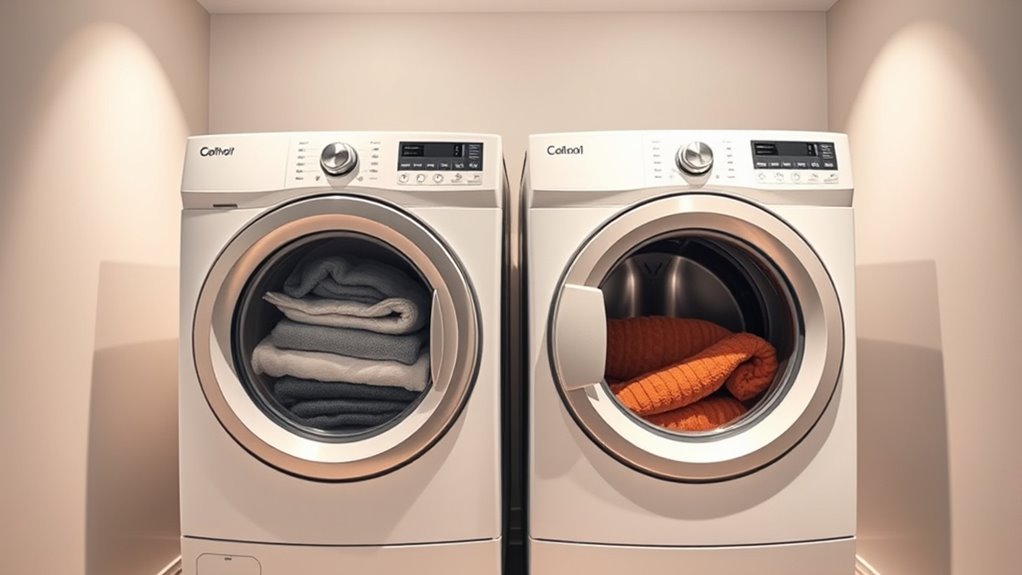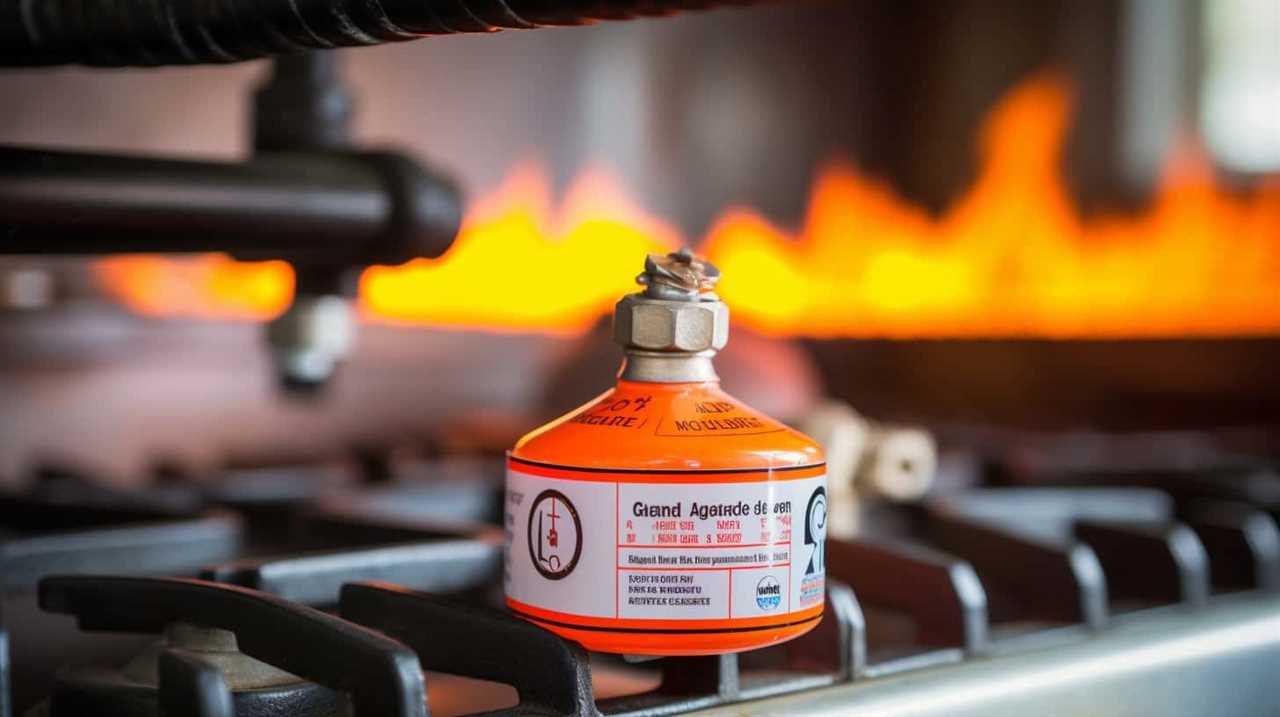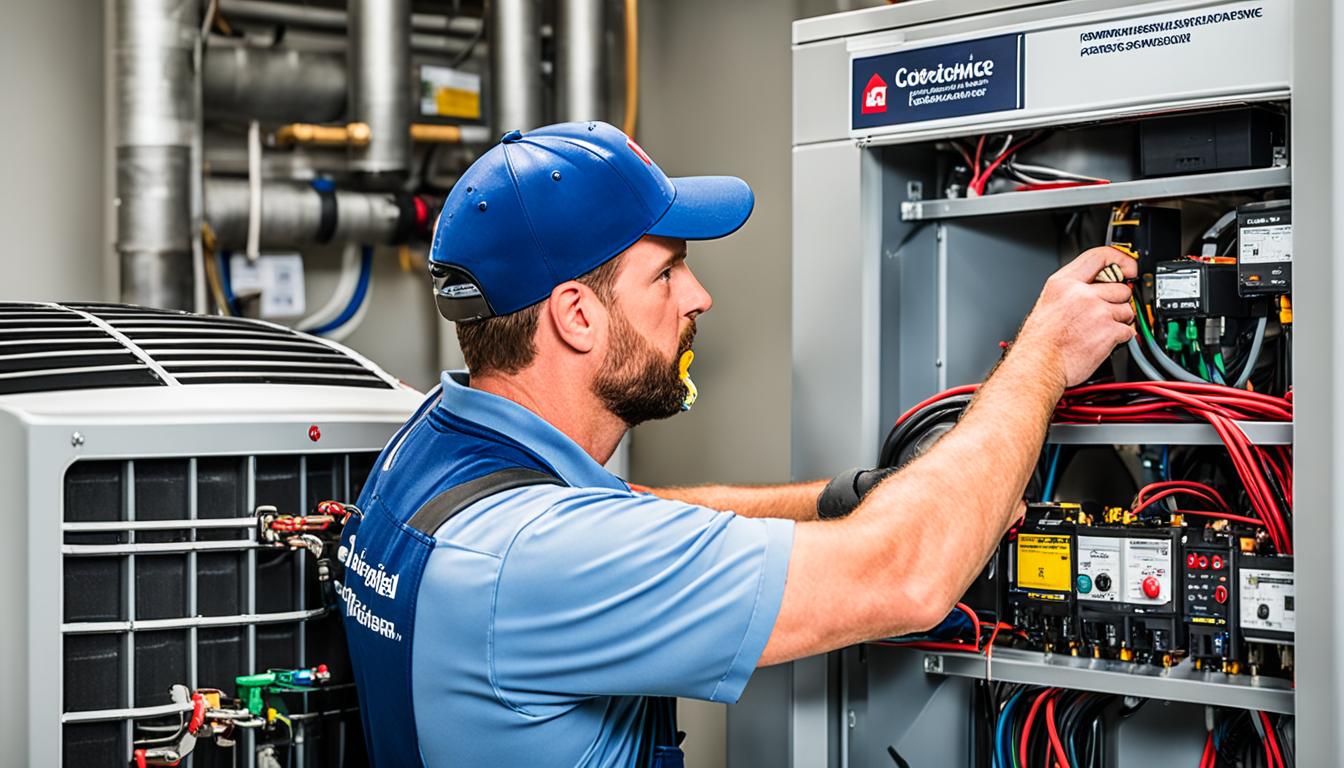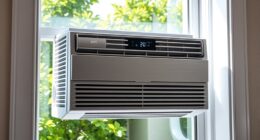To avoid overloading your washer and dryer, it’s essential to choose the correct capacity based on your household size and laundry needs. An overloaded machine struggles to clean or dry clothes efficiently, wastes energy, and wears out faster. Typically, a washer capacity of 3.5 to 4.5 cubic feet suits singles and couples, while larger families need 4.5 to 5.5 cubic feet. Ensuring proper fit improves efficiency and extends appliance life—more details await to help you optimize your laundry routine.
Key Takeaways
- Choose washer and dryer capacities based on household size to prevent overloading and ensure efficient operation.
- Proper capacity helps maintain appliance longevity by avoiding excessive wear caused by overloading.
- Matching load size with machine capacity reduces cycle times, energy use, and the need for multiple wash or dry cycles.
- Overloading hampers proper cleaning and drying, leading to uneven results and additional appliance strain.
- Dryer capacity should be about 75% of washer capacity for optimal drying efficiency and to prevent clothes from staying wet.

Choosing the right washer and dryer capacity is essential to guarantee your laundry loads are efficient and effective. When you select appliances that match your household’s needs, you optimize energy efficiency and keep laundry cycle durations manageable. Overloading your washer can lead to longer cycles because the machine struggles to agitate clothes properly, which wastes energy and extends cleaning time. Similarly, if your dryer is overloaded, clothes won’t tumble freely, resulting in uneven drying and additional cycles. By understanding the appropriate capacity for your laundry, you ensure each load is cleaned thoroughly without unnecessary energy consumption or wasted time. Proper capacity helps prevent wear and tear on your appliances and maintains their longevity. A washer with a capacity that’s too small for your typical load means you’ll need to run multiple cycles to wash the same amount of laundry, which increases water and electricity use. Conversely, a washer that’s too large for your needs might be inefficient because it uses more energy than necessary for small loads. To find the right fit, consider how much laundry you usually do in a week. For a single person or couple, a washer with a capacity of around 3.5 to 4.5 cubic feet often suffices. For larger families or households that generate more laundry, a bigger machine—perhaps 4.5 to 5.5 cubic feet—can handle bigger loads without sacrificing efficiency. The same principles apply to your dryer. An appropriately sized dryer will dry clothes evenly and quickly, minimizing energy use and reducing laundry cycle durations. Overloading the dryer causes clothes to stay wet longer, forcing you to run additional cycles. This not only wastes energy but also puts extra wear on your appliances, reducing their lifespan. On the other hand, underloading a dryer can be inefficient because the machine runs for a full cycle with only a few items, wasting energy and time. Aim for a dryer capacity that matches your washer’s load size, typically about 75% of the washer’s capacity, to optimize drying times and energy efficiency.
Frequently Asked Questions
How Do I Measure My Laundry Load Accurately?
To gauge your laundry load precisely, start by sorting clothes by fabric type and weight. Don’t overload your washer or dryer; leave enough space for water and movement. Use the right amount of detergent based on load size, not just the machine’s capacity. Check your machine’s manual for load guidelines, and remember, a full but not overloaded load ensures thorough cleaning and proper drying.
What Are the Signs of Overloading My Washer or Dryer?
Think of your washer or dryer as a busy dance floor—overloading causes chaos. If you see clothes bursting out, uneven spins, or longer drying times, you’re overdoing it. Overloading reduces detergent efficiency and risks fabric damage, leaving your clothes less clean and more worn. Pay attention to these signs, give your machine room to breathe, and your laundry will thank you with cleaner, longer-lasting results.
Can I Exceed the Recommended Capacity Occasionally?
You can occasionally surpass the recommended capacity, but it’s not ideal for your washer or dryer. Ignoring capacity limitations can lead to poor laundry pile management, longer drying times, and potential damage to your appliances. To keep things running smoothly, stick close to the capacity limits and load your laundry evenly. This helps prevent strain on your machines and ensures efficient washing and drying every time.
Are There Benefits to Underloading the Washer or Dryer?
Yes, there are benefits to underloading your washer or dryer. When you do, you improve energy efficiency because the machine doesn’t have to work as hard or use extra resources. Additionally, underloading helps with fabric care, reducing wear and tear on your clothes. This means they last longer and stay looking their best. Just remember not to underload too often, as it can waste energy and water.
How Does Capacity Vary Between Different Washer and Dryer Models?
Think of washer and dryer models as different-sized backpacks—you need the right capacity for your load size. Capacity specifications vary widely, from compact units perfect for small loads to large models handling bulky bedding. When choosing, consider how much laundry you typically do. Larger capacities let you wash more in one go, saving time, while smaller models suit lighter, everyday loads. Always match your load size to the appliance’s capacity for ideal performance.
Conclusion
Now that you know how important proper washer and dryer capacity is, you can avoid the chaos of overloading, much like avoiding a Roman chariot crash. Keep your laundry room running smoothly by matching your machine’s size to your needs. Remember, a well-chosen load saves time and energy, helping you conquer laundry day with the efficiency of a modern hero—no more laundry mishaps or medieval messes. Happy washing!










